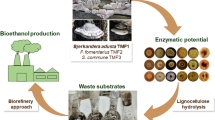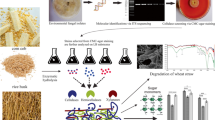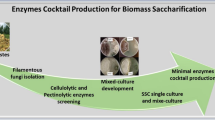Abstract
The present study aimed to discover good lignocellulolytic enzyme (LCE) producers from Thailand’s tropical forest and then examine their multiple LCE production (including carboxymethyl cellulase (CMCase), xylanase, and laccase) using agricultural wastes as substrate. The total collection was 50 fungi, mainly from the Polyporales, Agaricales, and Xylariales orders. During primary screening by qualitative method and secondary screening by quantitative method, two potential fungi were proposed for multiple LCE production, including Auricularia auricula-judae 088 and Pseudolagarobasidium acaciicola TDW-48. Under solid-state fermentation (SSF) using agricultural wastes as substrates, P. acaciicola TDW-48 performed as a good producer that highly secreted simultaneous CMCase, xylanase, and laccase. In the next stage, the simplex lattice mixture design assessed the interaction of agricultural waste substrates and their effects on P. acaciicola TDW-48’s enzyme production. The results indicated that agricultural waste has different influences on CMCase, xylanase, and laccase production: orange peel showed a positive effect on both CMCase and xylanase activity, but a negative effect on laccase. In contrast, wheat bran positively influenced laccase, while it limited CMCase and xylanase. However, the combination of these substrates in the mixture showed synergic effects and improved enzyme activity. Through numerical optimization, a ternary mixture of wheat bran (1.27 g), orange peel (1.53 g), and rice husk (0.2 g) was identified as the most appropriate formulation for simultaneous multiple LCE production, reaching 20.96 U/g substrate for CMCase, 23.94 U/g substrate for xylanase, and 27.55 U/g substrate for laccase. These results provided a promising candidate for LCE production with high applicability in lignocellulose bioconversion and successfully demonstrated the relationship between the agricultural waste substrate and multiple LCE production that supported the enzyme production following the environmentally friendly and economical approach.











Similar content being viewed by others
Data availability
The data supporting this study’s findings are available in the article.
References
Chuen NL, Sabri M, Ghazali M et al (2021) Agro-waste-derived silica nanoparticles (Si-NPs) as biofertilizer. In: Bhat R (ed) Valorization of agri-food wastes and by-products. Academic Press, pp 881–897
Liu Y, Tang Y, Gao H et al (2021) Challenges and future perspectives of promising biotechnologies for lignocellulosic biorefinery. Molecules 26:5411. https://doi.org/10.3390/molecules26175411
Li H, Dou M, Wang X et al (2021) Optimization of cellulase production by a novel endophytic fungus Penicillium oxalicum R4 isolated from Taxus cuspidata. Sustainability 13:6006. https://doi.org/10.3390/su13116006
Ubando AT, Felix CB, Chen W-H (2020) Review Biorefineries in circular bioeconomy: a comprehensive review. Bioresour Technol 299:122585. https://doi.org/10.1016/j.biortech.2019.122585
Lopes AM, Ferreira Filho EX, Moreira LRS (2018) An update on enzymatic cocktails for lignocellulose breakdown. J Appl Microbiol 125:632–645. https://doi.org/10.1111/jam.13923
Van Dyk JS, Pletschke BI (2012) A review of lignocellulose bioconversion using enzymatic hydrolysis and synergistic cooperation between enzymes-factors affecting enzymes, conversion and synergy. Biotechnol Adv 30:1458–1480. https://doi.org/10.1016/j.biotechadv.2012.03.002
Adsul M, Sandhu SK, Singhania RR et al (2020) Designing a cellulolytic enzyme cocktail for the efficient and economical conversion of lignocellulosic biomass to biofuels. Enzyme Microb Technol 133:109442. https://doi.org/10.1016/j.enzmictec.2019.109442
Méndez-Líter JA, de Eugenio LI, Nieto-Domínguez M et al (2021) Hemicellulases from Penicillium and Talaromyces for lignocellulosic biomass valorization: a review. Bioresour Technol 324:124623. https://doi.org/10.1016/j.biortech.2020.124623
Ma K, Ruan Z (2015) Production of a lignocellulolytic enzyme system for simultaneous bio-delignification and saccharification of corn stover employing co-culture of fungi. Bioresour Technol 175:586–593. https://doi.org/10.1016/j.biortech.2014.10.161
Zhuo R, Fan F (2021) A comprehensive insight into the application of white rot fungi and their lignocellulolytic enzymes in the removal of organic pollutants. Sci Total Environ 778:146132. https://doi.org/10.1016/j.scitotenv.2021.146132
Grelska A, Noszczyńska M (2020) White rot fungi can be a promising tool for removal of bisphenol A, bisphenol S, and nonylphenol from wastewater. Environ Sci Pollut Res Int 27:39958. https://doi.org/10.1007/S11356-020-10382-2
Suryadi H, Judono JJ, Putri MR et al (2022) Biodelignification of lignocellulose using ligninolytic enzymes from white-rot fungi. Heliyon 8:e08865. https://doi.org/10.1016/j.heliyon.2022.e08865
Santos FA, de Carvalho-Gonçalves LCT, de Carvalho Cardoso-Simões AL, de Melo Santos SF (2021) Evaluation of the production of cellulases by Penicillium sp. FSDE15 using corncob and wheat bran as substrates. Bioresour Technol Rep 14:100648. https://doi.org/10.1016/j.biteb.2021.100648
Leite P, Sousa D, Fernandes H et al (2021) Recent advances in production of lignocellulolytic enzymes by solid-state fermentation of agro-industrial wastes. Curr Opin Green Sustain Chem 27:100407. https://doi.org/10.1016/j.cogsc.2020.100407
Iram A, Cekmecelioglu D, Demirci A (2021) Ideal feedstock and fermentation process improvements for the production of lignocellulolytic enzymes. Processes 9:1–26. https://doi.org/10.3390/pr9010038
Ohara A, Dos SJG, Angelotti JAF et al (2018) A multicomponent system based on a blend of agroindustrial wastes for the simultaneous production of industrially applicable enzymes by solid-state fermentation. Food Science and Technology (Brazil) 38:131–137. https://doi.org/10.1590/1678-457x.17017
da Silva NN, Carneiro LL, de Menezes LHS et al (2020) Simplex-centroid design and artificial neural network-genetic algorithm for the optimization of exoglucanase production by Penicillium roqueforti ATCC 10110 through solid-state fermentation using a blend of agroindustrial wastes. Bioenergy Res 13:1130–1143. https://doi.org/10.1007/s12155-020-10157-0
Ding S, Hu H, Gu JD (2020) Diversity, abundance, and distribution of wood-decay fungi in major parks of Hong Kong. Forests 11:1030. https://doi.org/10.3390/f11101030
Senanayake IC, Rathnayaka AR, Marasinghe DS et al (2020) Morphological approaches in studying fungi: collection, examination, isolation, sporulation and preservation. Mycosphere 11:2678–2754. https://doi.org/10.5943/mycosphere/11/1/20
Phillips R (2013) Mushrooms_ a comprehensive guide to mushroom identification. London, UK, Pan Macmillan
Barnett HL, Hunter BB (1998) Illustrated genera of imperfect fungi, fourth. Macmillan, New York
Guarro J, Gene J, Stchigel AM, Figueras MJ (2012) Atlas of soil Ascomycetes. In: CBS Biodiversity Series 10. CBS-KNAW Fungal Biodiversity Centre, Utrecht, The Netherlands
Tangthirasunun N, Poeaim S (2022) Studies on the rapid and simple DNA extraction method, antibacterial activity and enzyme activity involved in plant biomass conversion by Cookeina sulcipes and C. tricholoma (cup fungi). J Pure Appl Microbiol 16:2851–2863. https://doi.org/10.22207/jpam.16.4.58
Ghislain M, Zhang D, Herrera MR (1999) Molecular biology laboratory protocols: plant genotyping, 2nd edn. Crop Improvement and Genetic Resources Department, Training Manual, International Potato Center (CIP), Lima
White TJ, Bruns T, Lee S, Taylor J (1990) Amplification and direct sequencing of fungal ribosomal RNA genes for phylogenetics. In: Innis MA, David H. Gelfand DH, Sninsky JJ, White TJ (eds) PCR protocols: a guide to methods and applications. Academic Press, pp 315–322. https://doi.org/10.1016/b978-0-12-372180-8.50042-1
Tangthirasunun N, Silar P, Bhat DJ et al (2014) Morphology and phylogeny of Pseudorobillarda eucalypti sp. nov., from Thailand. Phytotaxa 176:251–259. https://doi.org/10.11646/phytotaxa.176.1.24
Neethu K, Rubeena M, Sajith S et al (2012) A novel strain of Trichoderma viride shows complete lignocellulolytic activities. Adv Biosci Biotechnol 03:1160–1166. https://doi.org/10.4236/abb.2012.38142
Shrestha P, Joshi B, Joshi J et al (2016) Isolation and physicochemical characterization of laccase from Ganoderma lucidum-CDBT1 isolated from its native habitat in Nepal. Biomed Res Int 2016:3238909. https://doi.org/10.1155/2016/3238909
Sánchez-Corzo LD, Álvarez-Gutiérrez PE, Meza-Gordillo R et al (2021) Lignocellulolytic enzyme production from wood rot fungi collected in Chiapas, Mexico, and their growth on lignocellulosic material. J Fungi 7:450. https://doi.org/10.3390/jof7060450
Ghose TK (1987) Measurement of cellulase activities. Pure Appl Chem 59:257–268. https://doi.org/10.1351/pac198759020257
Csarman F, Obermann T, Zanjko MC et al (2021) Functional expression and characterization of two laccases from the brown rot Fomitopsis pinicola. Enzyme Microb Technol 148:109801. https://doi.org/10.1016/j.enzmictec.2021.109801
Cardoso WS, Queiroz PV, Tavares GP et al (2018) Multi-enzyme complex of white rot fungi in saccharification of lignocellulosic material. Braz J Microbiol 49:879–884. https://doi.org/10.1016/j.bjm.2018.05.006
Berrin JG, Navarro D, Couturier M et al (2012) Exploring the natural fungal biodiversity of tropical and temperate forests toward improvement of biomass conversion. Appl Environ Microbiol 78:6483–6490. https://doi.org/10.1128/aem.01651-12
Chew ALC, Desjardin DE, Tan Y-S et al (2015) Bioluminescent fungi from Peninsular Malaysia-a taxonomic and phylogenetic overview. Fungal Divers 70:149–187. https://doi.org/10.1007/s13225-014-0302-9
Nguyen KA, Kumla J, Suwannarach N et al (2019) Optimization of high endoglucanase yields production from polypore fungus, Microporus xanthopus strain KA038 under solid-state fermentation using green tea waste. Biol Open 8:bio047183. https://doi.org/10.1242/bio.047183
Metreveli E, Kachlishvili E, Singer SW, Elisashvili V (2017) Alteration of white-rot basidiomycetes cellulase and xylanase activities in the submerged co-cultivation and optimization of enzyme production by Irpex lacteus and Schizophyllum commune. Bioresour Technol 241:652–660. https://doi.org/10.1016/j.biortech.2017.05.148
Vats A, Mishra S (2020) Laccase isoform diversity on basal medium in Cyathus bulleri and role in decolorization/detoxification of textile dyes and effluent. World J Microbiol Biotechnol 36:164. https://doi.org/10.1007/s11274-020-02939-7
Adak A, Tiwari R, Singh S et al (2016) Laccase production by a novel white-rot fungus Pseudolagarobasidium acaciicola LA 1 through solid-state fermentation of Parthenium biomass and its application in dyes decolorization. Waste Biomass Valorization 7:1427–1435. https://doi.org/10.1007/s12649-016-9550-0
Goh SM, Chan MY, Ong LGA (2017) Degradation potential of basidiomycetes Trametes ljubarskyi on Reactive Violet 5 (RV 5) using urea as optimum nitrogen source. Biotechnol Biotechnol Equip 31:743–748. https://doi.org/10.1080/13102818.2017.1334591
Lu X, Li F, Zhou X et al (2022) Biomass, lignocellulolytic enzyme production and lignocellulose degradation patterns by Auricularia auricula during solid state fermentation of corn stalk residues under different pretreatments. Food Chem 384:132622. https://doi.org/10.1016/j.foodchem.2022.132622
Coniglio RO, Fonseca MI, Villalba LL, Zapata PD (2017) Screening of new secretory cellulases from different supernatants of white rot fungi from Misiones, Argentina. Mycology 8:1–10. https://doi.org/10.1080/21501203.2016.1267047
Pukahuta C, Suwanarit P, Shianagawa E et al (2004) Combination of laccase, xylanase and cellulase in lignocellulose degradation by white rot fungi, Lentinus polychrous Lev. and L. squarrosulus Mont. Kasetsart Journal - Natural Science 38:65–73
Vaithanomsat P, Sangnam A, Boonpratuang T et al (2013) Wood degradation and optimized laccase production by resupinate white-rot fungi in northern Thailand. Bioresources 8:6342–6360. https://doi.org/10.15376/biores.8.4.6342-6360
Wang Q, Qian Y, Ma Y, Zhu C (2018) A preliminary study on the newly isolated high laccase-producing fungi: screening, strain characteristics and induction of laccase production. Open Life Sci 13:463–469. https://doi.org/10.1515/biol-2018-0055
Thakur S, Gupte A (2015) Optimization and hyper production of laccase from novel agaricomycete Pseudolagarobasidium acaciicola AGST3 and its application in in vitro decolorization of dyes. Ann Microbiol 65:185–196. https://doi.org/10.1007/s13213-014-0849-4
Teigiserova DA, Bourgine J, Thomsen M (2021) Closing the loop of cereal waste and residues with sustainable technologies: an overview of enzyme production via fungal solid-state fermentation. Sustain Prod Consum 27:845–857. https://doi.org/10.1016/j.spc.2021.02.010
Xu X, Lin M, Zang Q, Shi S (2018) Solid state bioconversion of lignocellulosic residues by Inonotus obliquus for production of cellulolytic enzymes and saccharification. Bioresour Technol 247:88–95. https://doi.org/10.1016/j.biortech.2017.08.192
Kaur J, Chugh P, Soni R, Soni SK (2020) A low-cost approach for the generation of enhanced sugars and ethanol from rice straw using in-house produced cellulase-hemicellulase consortium from A. niger P-19. Bioresour Technol Rep 11:100469. https://doi.org/10.1016/j.biteb.2020.100469
Salomão GSB, Agnezi JC, Paulino LB et al (2019) Production of cellulases by solid state fermentation using natural and pretreated sugarcane bagasse with different fungi. Biocatal Agric Biotechnol 17:1–6. https://doi.org/10.1016/j.bcab.2018.10.019
Sun HY, Li J, Zhao P, Peng M (2011) Banana peel: a novel substrate for cellulase production under solid-state fermentation. Afr J Biotechnol 10:17887–17890. https://doi.org/10.5897/ajb10.1825
Atalla SMM, El Gamal NG (2020) Production and characterization of xylanase from pomegranate peel by Chaetomium globosum and its application on bean under greenhouse condition. Atalla Gamal Bull Nat Res Cent 44:104. https://doi.org/10.1186/s42269-020-00361-5
Chakraborty S, Gupta R, Jain KK, Kuhad RC (2016) Cost-effective production of cellulose hydrolysing enzymes from Trichoderma sp. RCK65 under SSF and its evaluation in saccharification of cellulosic substrates. Bioprocess Biosyst Eng 39:1659–1670. https://doi.org/10.1007/s00449-016-1641-6
da Silva DP, Pirota RDPB, Codima CA et al (2012) Using Amazon forest fungi and agricultural residues as a strategy to produce cellulolytic enzymes. Biomass Bioenergy 37:243–250. https://doi.org/10.1016/j.biombioe.2011.12.006
Abd El Aty AA, Hamed ER, El-Beih AA, El-Diwany AI (2016) Induction and enhancement of the novel marine-derived Alternaria tenuissima KM651985 laccase enzyme using response surface methodology: application to Azo and Triphenylmethane dyes decolorization. J Appl Pharm Sci 6:6–14. https://doi.org/10.7324/japs.2016.60402
Gautam A, Kumar A, Bharti AK, Dutt D (2018) Rice straw fermentation by Schizophyllum commune ARC-11 to produce high level of xylanase for its application in pre-bleaching. J Gen Eng Biotechnol 16:693–701. https://doi.org/10.1016/j.jgeb.2018.02.006
Johnson Adeleke A, Olanbiwoninu A, Owoseni M et al (2012) Production of cellulase and pectinase from orange peels by fungi. Nat Sci (East Lansing) 10:107–112
Inácio FD, Ferreira RO, de Araujo CAV et al (2015) Production of enzymes and biotransformation of orange waste by Oyster mushroom, Pleurotus pulmonarius (Fr.) Quél. Adv Microbiol 05:1–8. https://doi.org/10.4236/aim.2015.51001
Srivastava N, Srivastava M, Manikanta A et al (2017) Production and optimization of physicochemical parameters of cellulase using untreated orange waste by newly isolated Emericella variecolor NS3. Appl Biochem Biotechnol 183:601–612. https://doi.org/10.1007/s12010-017-2561-x
Sharma D, Garlapati VK, Goel G (2016) Bioprocessing of wheat bran for the production of lignocellulolytic enzyme cocktail by Cotylidia pannosa under submerged conditions. Bioengineered 7:88–97. https://doi.org/10.1080/21655979.2016.1160190
Taherzadeh-Ghahfarokhi M, Panahi R, Mokhtarani B (2019) Optimizing the combination of conventional carbonaceous additives of culture media to produce lignocellulose-degrading enzymes by Trichoderma reesei in solid state fermentation of agricultural residues. Renew Energy 131:946–955. https://doi.org/10.1016/j.renene.2018.07.130
Acknowledgements
The authors would like to thank Assistant Professor Thanarak Chantaraprasit for helping to take good pictures during the sample collection. Thi Thu Huong Luong thanks King Mongkut’s Institute of Technology Ladkrabang for the doctoral scholarship.
Funding
This research was financially supported by King Mongkut’s Institute of Technology Ladkrabang (KMITL) under Grant numbers KDS2020/048 and A118-0261–010.
Author information
Authors and Affiliations
Contributions
Conceptualization: TTHL and SP; writing—original draft preparation: TTHL; writing—review and editing: SP, PS, and TTHL; supervision: SP and NT. All authors read and approved the final manuscript.
Corresponding author
Ethics declarations
Ethical approval
Not applicable.
Competing interests
The authors declare no competing interests.
Additional information
Publisher's Note
Springer Nature remains neutral with regard to jurisdictional claims in published maps and institutional affiliations.
Rights and permissions
Springer Nature or its licensor (e.g. a society or other partner) holds exclusive rights to this article under a publishing agreement with the author(s) or other rightsholder(s); author self-archiving of the accepted manuscript version of this article is solely governed by the terms of such publishing agreement and applicable law.
About this article
Cite this article
Luong, T.T.H., Silar, P., Poeaim, S. et al. Isolation, screening wood rot fungi from the tropical forest of Thailand and their lignocellulolytic enzyme production under solid-state fermentation using agricultural waste as substrate. Biomass Conv. Bioref. (2023). https://doi.org/10.1007/s13399-023-05129-1
Received:
Revised:
Accepted:
Published:
DOI: https://doi.org/10.1007/s13399-023-05129-1




